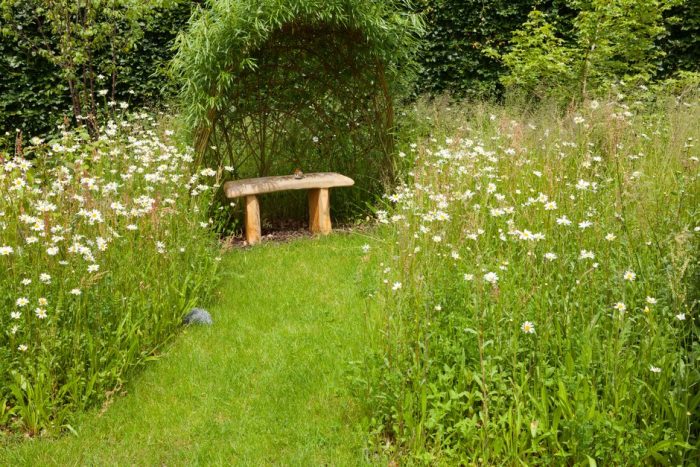
A visit to Chelsea Flower Show doesn’t usually save you money, as anyone who has visited and come back with masses of ideas and purchases will attest. By Gill Maccabe
If you embrace just a few of the top tips promoted at the Chelsea Flower Show this year, you are guaranteed to save pounds – and you will have more time to relax and enjoy your little piece of real estate with friends and family.
Today’s top garden designers are now promoting how to spend less, do less work, produce less waste but still have a fantastic garden and more time in which to enjoy it.
But how?
Goodbye formal borders…let everything grow beyond the lines.
Blur the edges and let your plants grow freely. Hard edges on borders are disappearing and many show gardens embraced a wilder look this year, by allowing plants to spill over the edges and grow throughout the paths and walkways, this cuts down on edging material, strimming and weeding.
Embrace weeds and start seeing them as wildflowers.
Not a new idea but slowly attracting favour. Whilst it is very difficult to grow a decent wildflower patch, as it requires constant weeding and colour coding, certain flowers will quickly naturalise if you let them and give them space. Invariably, mother nature includes a lot of yellow-coloured weeds and wildflowers. If you want purple and blue, however, then you can pick what you like from the hedgerows and they will root quickly in warm compost.
I particularly like the nodding habit of the yellow and white ox eye daisies (Leucanthemum vulgare); the gorgeous pink herb (Geranium robertianum); the vivid purple field thistle (Cirsium discolour), which makes the most delicious honey and in certain winds can actually smell like honey; beautiful red campion (Silene dioica); and the tall, red poppy sometimes called the opium poppy (Papaver somniferum). The seeds are borne in a spherical capsule topped by a disk formed by the stigmas of the flower. Just shake the capsule and you are guaranteed a repeat appearance the following year.
No May mow – let it bloom June
An initiative that encourages people to stop, or at least mow less often, for the month of May, to provide habitat and food for early season pollinators. If you are not yet ready to gaze out on a lawn of wild grass, then why not create a couple of manicured paths to your favourite seat and let the grass grow around them – you’ll be surprised by how many plants appear and not weeds as you would first think.
Allowing at least some of the grass to grow tall, perhaps with mown paths through the taller areas, is highly beneficial to wildlife and brings advantages to birds, hedgehogs, shrews, mice, toads and slowworms who shelter by day in beds and borders where they keep down slugs, weevils and other pests. Longer grass near ponds shelters froglets and other young amphibians as they disperse in summer.
Low Carbon landscaping
Dead wood was a constant feature in gardens in Chelsea this year. If you have lost a tree or a few branches have fallen off, leave them where they land and use them as a natural stage for climbing flowers. You can have an instant same-year splash of colour by popping a few seeds of morning glory (Iopmea tricolor) in the ground in March or April or for longer lasting colour, plant Clematis montana. In a couple of years, it will reward you with a profuse carpet of pink flowers, which will flower for weeks and be loved by pollinators. Plus, the dead wood will provide a useful habitat for insects.
Rather than using imported bamboo canes, grow your own plant supports from coppiced hazel poles or waste wood and prunings. Use cement-free concrete and reclaimed or salvaged material for rockeries.
Don’t spend money on the best garden furniture – do spend it on a beautiful Indian patterned tablecloth thrown over a decorators table or even a piece of ply on legs and look totally on trend for a fraction of the cost.
Finally, instead of forking out hundreds on annual bedding plants and seeds, choose shrubs such as hydrangeas, salvias, verbena, lavender and agapanthus, for example. In a few years they will bulk up and there will be no need for underplanting. And most importantly, they will leave no room for weeds!




